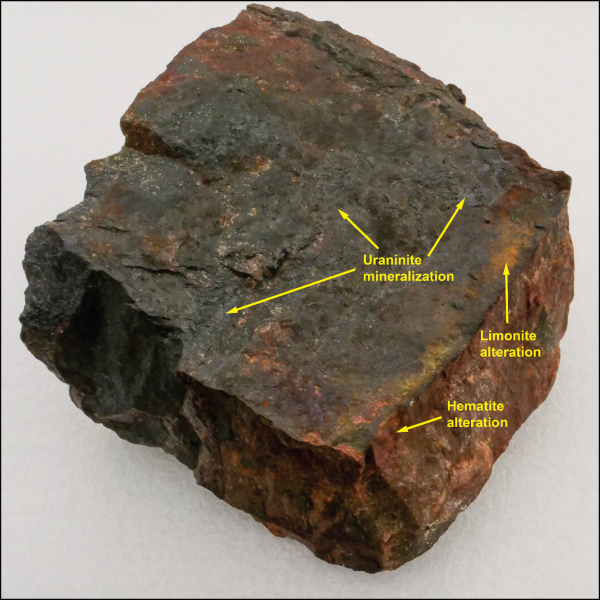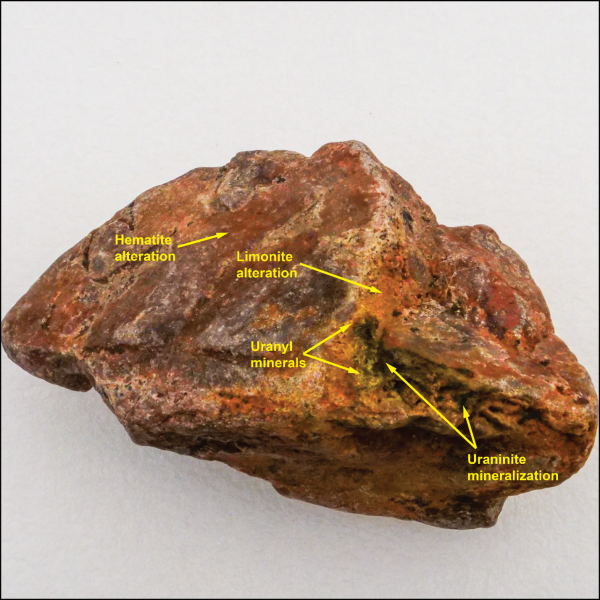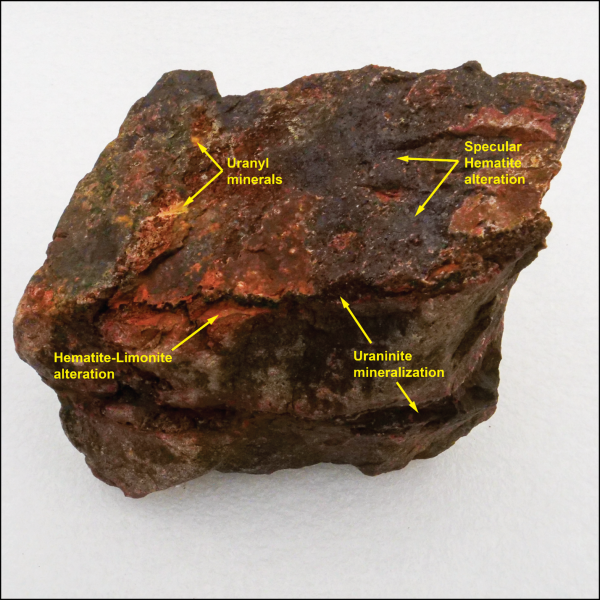Vancouver, British Columbia, October 19, 2021 — Standard Uranium Ltd. (“Standard Uranium” or the “Company”) (TSX-V: STND) (OTCQB: STTDF) (Frankfurt: FWB:9SU) is pleased to announce the signing of an Engagement Agreement with Ya’thi Néné Land and Resource Office (“YNLR”)1 , further strengthening the Company’s relationships with First Nations and northern community stakeholders. The Company is also pleased to announce plans for their winter exploration program including high resolution geophysics and diamond drilling at its 15,770-hectare, 100% wholly-owned, Sun Dog Project (the “Project”). The Project is located at the northwestern edge of the Athabasca Basin, Saskatchewan, and is south of the first uranium mining camp in Canada, the Beaverlodge District, near Uranium City.
Following the signing of the Engagement Agreement with the YNLR on October 12th, 2021, CEO and President, Jon Bey, and VP Exploration, Sean Hillacre, visited the Sun Dog project on October 14th. During which, they followed up on occurrences of mineralization and strong radioactivity at surface with an RS-125 scintillometer, recording readings of >63,000 counts per second (“cps”) at the Skye target, readings of >27,000 cps at the Java Target, and to readings of >40,000 cps at the Haven target which was recently discovered by the Company in 2020 (Figure 1).
Jon Bey, CEO and President commented: “Signing the Engagement Agreement with our First Nations and northern community representatives is a milestone event for our team at Standard Uranium and a step towards building strong relationships with local stakeholders. We have been anxiously awaiting the opportunity to explore the Sun Dog Project knowing the potential for high-grade uranium discoveries in this region. Working closely with our local stakeholders, we have the potential to bring opportunities back to this incredible region.”

Figure 1. Property overview of the Sun Dog Project showing Skye, Haven and Java target areas in context of historical drilling results, geophysical anomalies, and historical prospects including JSW-1, JSW-2, and Walli. The Haven discovery zone is situated in the center of the Haven target area.
Sun Dog Project Planned Winter Exploration Program
The Sun Dog Project is fully permitted for the 2022 exploration program, and the Company is fully funded for it’s 2022 exploration plans on the Project. The Company plans to conduct high resolution airborne magnetic and ground gravity surveys over the Skye, Haven and Java target areas on the Sun Dog Project (Figure 1) through the months of January and February 2022, leading into the inaugural drill program planned to commence in the first week of March 2022. The drill program will comprise up to 3,000 metres of diamond drilling to test high priority basement and unconformity targets for high-grade uranium mineralization at relatively shallow depths.
Sean Hillacre, VP Exploration, states: “I was extremely impressed by the abundance of structural features and uranium mineralization occurrences on the Sun Dog Project during my first visit to our target areas. The extent of the faulting and brecciation in the Athabasca sandstones and exposed basement rocks coinciding with strong radioactivity on surface at our Skye target, Java target and Haven discovery has me excited to begin our inaugural drill program and follow up on the basement “roots” of these perched mineralization systems. The strong alteration and uranium mineralization occurrences at surface bode extremely well for what is potentially contained within the down-dip extension of these major structures into the basement rocks below.”
As noted in the December 8, 2020, news release, the target areas at the Sun Dog Project have many attributes that are favourable for the formation of high-grade unconformity-related uranium mineralization. The key geological factors include uranium-enriched bedrock, reactivated and graphitized structures, Athabasca Supergroup sandstone cover and favourable basement competency contrasts. The three most promising historical target areas (Skye and Java, in addition to the newly discovered Haven target) were visited in the summer of 2020 to confirm the location of historical exploration and provide context for future work. The analytical results reveal an interesting correlation between uranium and gold mineralization, whereas boron and other pathfinder elements highlight the potential for a robust alteration footprint at the Haven target area.
Ground-truth sampling in 2020 at the three main target areas: Skye, Java, and Haven, have returned outcrop and boulder grab sample results with highs of 3.58% U308, 1.7% U308 and 0.7% U308, respectively. These high-grade uranium assay results come from widespread showings of strong radioactivity on Stewart and Johnston Islands.
New boulder grab samples were also collected from the Skye target area during the recent 2021 visit, with radiation measurements peaking at 42,000 cps (Figure 2), 27,000 cps (Figure 3) and 12,000 cps (Figure 4). These samples will be shipped to Saskatchewan Research Council in Saskatoon to provide additional U3O8 assay data for follow up at the Skye target area.
Fall 2020 Exploration Highlights:
Skye Target Area
- 14 outcrop and boulder grab samples collected, 2 of which are greater than 0.10% U308, and range between 0.95 ppm U and 3.58% U308.
- 3 of the 14 samples returned greater than 100 ppb gold with a high of 1.02 g/t Au.
Java Target Area - JSW-1 prospect
- 14 outcrop grab samples collected, 10 of which are greater than 0.10% U308, and range between 0.07 ppm U and 1.7% U308.
- 8 of the 14 samples returned greater than 100 ppb gold with a high of 0.52 g/t Au.
Haven Discovery Area – Haven target, Walli prospect, JSW-2 prospect
- 13 outcrop grab samples collected, 5 of which are greater than 0.10% U308, and range between 136 ppm U and 0.70% U308.
- 3 of the 13 samples returned greater than 100 ppb of gold, with a high of 1.04 g/t Au.
- Proximal to the historical Walli Prospect (Figure 1), 2 of the 13 samples returned greater than 1,000 ppm of boron. These results, coupled with the anomalous uranium of 0.10 and 0.13% U308 and elevated pathfinder elements such as lead, copper, cobalt, and nickel suggest the identification of a robust alteration footprint within the Athabasca sandstones.
Figure 2. Boulder grab sample from the Skye target area containing black metallic uraninite mineralization and associated red-orange hematite-limonite alteration; Sample size: 11 cm x 12 cm x 6 cm; Up to 42,000 counts per second.
Figure 3. Boulder grab sample from the Skye target area containing black uraninite mineralization and canary yellow secondary uranyl-oxyhydroxide minerals. Strong hematite alteration is pervasive through the sample with local orange limonite alteration; Sample size: 9 cm x 18 cm x 6 cm; Up to 27,000 counts per second.
Figure 4. Boulder grab sample from the Skye target area containing vein- and bedding-controlled uraninite mineralization associated with strong to intense hematite-limonite alteration. Local dark purple-red specular hematite and secondary yellow-orange uranyl minerals are noted along the fracture surface at the top of the sample; Sample size: 8 cm x 13 cm x 7 cm; Up to 12,000 counts per second.
The scientific and technical information contained in this news release has been reviewed and approved by Sean Hillacre, VP Exploration and is a “Qualified Person” as defined in NI 43-101.
Samples collected for analysis are sent to SRC Geoanalytical Laboratories (an SCC ISO/IEC 17025: 2005 Accredited Facility) in Saskatoon, SK for analysis. Sandstone samples were tested using the ICP-MS1 uranium multi-element exploration package plus boron. Basement samples were tested with ICP-MS2 uranium multi-element exploration package plus boron. All sandstone samples, and basement samples marked as radioactive upon arrival to the lab were also analyzed using the U308 assay (reported in wt %). All samples were tested with the Au1 gold by fire assay (reported in ppb and converted to g/t where appropriate).
Radioactivity measurements reported in this news release were measured using a handheld RS-125 Gamma-Ray Spectrometer/Scintillometer. Scintillometer readings do not constitute a qualitative or quantitative measurement of uranium concentration in the rock samples measured. Uranium mineralization referred to and pictured in samples in this news release have been identified based on mineralogical examination and scintillometer/spectrometer readings in conjunction with comparison and correlation with previously assayed samples.
About Standard Uranium (TSX-V: STND)
We find the fuel to power a clean energy future
Standard Uranium is a mineral resource exploration company based in Vancouver, British Columbia. Since its establishment, Standard Uranium has focused on the identification and development of prospective exploration stage uranium projects in the Athabasca Basin in Saskatchewan, Canada. Standard Uranium's Sun Dog Project, in the northwest part of the Athabasca Basin, Saskatchewan, is comprised of 6 mineral claims over 15,770 hectares. The Sun Dog Project is highly prospective for basement and unconformity hosted uranium deposits yet remains largely untested by sufficient drilling despite its location proximal to uranium discoveries in the area.
Standard Uranium’s Davidson River Project, in the southwest part of the Athabasca Basin, Saskatchewan, is comprised of 21 mineral claims over 25,886 hectares. The Davidson River Project is highly prospective for basement hosted uranium deposits yet remains relatively untested by drilling despite its location along trend from recent high-grade uranium discoveries. A copy of the NI 43-101 technical report that summarizes the exploration on the Davidson River Project is available for review under Standard Uranium’s SEDAR profile (www.sedar.com).
For further information contact:
Jon Bey, President, Chief Executive Officer, and Chairman
550 Denman Street, Suite 200
Vancouver, BC V6G 3H1
Tel: 1 (306) 850-6699
E-mail: info@standarduranium.ca
Cautionary Statement Regarding Forward-Looking Statements
This news release contains “forward-looking statements” or “forward-looking information” (collectively, “forward-looking statements”) within the meaning of applicable securities legislation. All statements, other than statements of historical fact, are forward-looking statements and are based on expectations, estimates and projections as of the date of this news release. Any statements that express or involve discussions with respect to predictions, expectations, beliefs, plans, projections, objectives, assumptions or future events or performance (often, but not always, identified by words or phrases such as “expects”, “is expected”, “anticipates”, “believes”, “plans”, “projects”, “estimates”, “assumes”, “intends”, “strategy”, “goals”, “objectives”, “forecasts”, “budget”, “schedule”, “potential”, “possible” or variations thereof or stating that certain actions, events, conditions or results “may”, “could”, “would”, “should”, “might” or “will” be taken, occur or be achieved, or the negative of any of these terms and similar expressions) are not statements of historical fact and may be forward-looking statements.
Forward-looking statements include, but are not limited to, statements regarding: the timing and content of upcoming work programs; geological interpretations; and estimates of market conditions.
Forward-looking statements are subject to a variety of known and unknown risks, uncertainties and other factors that could cause actual events or results to differ from those expressed or implied by forward-looking statements contained herein. There can be no assurance that such statements will prove to be accurate, as actual results and future events could differ materially from those anticipated in such statements. Certain important factors that could cause actual results, performance or achievements to differ materially from those in the forward-looking statements include, among others: general economic conditions in Canada and globally; industry conditions; governmental regulation of the mining industry, including environmental regulation; geological, technical and drilling problems; unanticipated operating events; competition for and/or inability to retain drilling rigs and other services; the availability of capital on acceptable terms; the need to obtain required approvals from regulatory authorities; stock market volatility; volatility in market prices for commodities; liabilities inherent in the mining industry; the development of the COVID-19 global pandemic; changes in tax laws and incentive programs relating to the mining industry. This list is not exhaustive of the factors that may affect the Company’s forward-looking statements. There may be other factors that could cause actual events or results to differ from those expressed or implied by forward-looking statements contained herein. See the section entitled “Risk Factors” in the Company’s annual information form for the fiscal year ended April 30, 2020, dated September 28, 2020, for additional risk factors that could cause actual events or results to differ from those expressed or implied by forward-looking statements contained herein.
Forward-looking statements are necessarily based upon a number of factors and assumptions that, if untrue, could cause actual events or results to differ from those expressed or implied by forward-looking statements contained herein. Forward-looking statements are based upon a number of estimates and assumptions that, while considered reasonable by the Company at this time, are inherently subject to significant business, economic and competitive uncertainties and contingencies that may cause the Company’s actual financial results, performance, or achievements to be materially different from those expressed or implied herein. Some of the material factors or assumptions used to develop forward-looking statements include, without limitation: the future price of uranium; anticipated costs and the Company’s ability to raise additional capital if and when necessary; volatility in the market price of the Company’s securities; future sales of the Company’s securities; the Company’s ability to carry on exploration and development activities; the success of exploration, development and operations activities; the timing and results of drilling programs; the discovery of mineral resources on the Company’s mineral properties; the costs of operating and exploration expenditures; the Company’s ability to identify, complete and successfully integrate acquisitions; the Company’s ability to operate in a safe, efficient and effective manner; health, safety and environmental risks; the presence of laws and regulations that may impose restrictions on mining; employee relations; relationships with and claims by local communities and indigenous populations; availability of increasing costs associated with mining inputs and labour; the speculative nature of mineral exploration and development (including the risks of obtaining necessary licenses, permits and approvals from government authorities); uncertainties related to title to mineral properties; assessments by taxation authorities; fluctuations in general macroeconomic
The forward-looking statements contained in this news release are expressly qualified by this cautionary statement. Any forward-looking statements and the assumptions made with respect thereto are made as of the date of this news release and, accordingly, are subject to change after such date. The Company disclaims any obligation to update any forward-looking statements, whether as a result of new information, future events or otherwise, except as may be required by applicable securities laws. There can be no assurance that forward-looking statements will prove to be accurate, as actual results and future events could differ materially from those anticipated in such statements. Accordingly, readers should not place undue reliance on forward-looking statements.
1 YNLR is a not-for-profit organization established by the Athabasca Basin First Nations of Black Lake Denesųłine First Nation, Fond du Lac Denesųłine First Nation and Hatchet Lake Denesųłine First Nation and the municipalities of Camsell Portage, Uranium City, Stony Rapids and Wollaston Lake with authority to represent certain First Nation communities.



